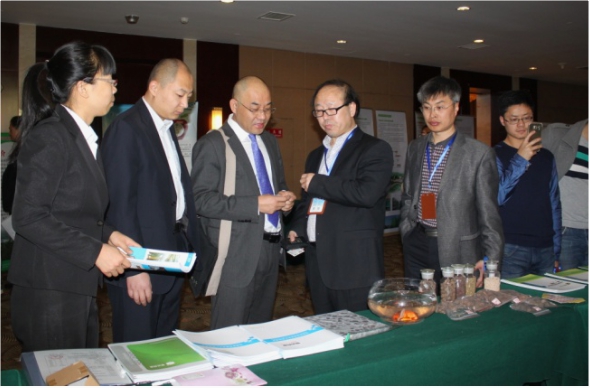1. overview of the meeting
from april 8 to 10, 2016, the 7th china advanced seminar on sludge treatment and disposal technology and application was held in tianjin. more than 900 representatives from scientific research institutes, water enterprises and equipment manufacturers attended the meeting. participating enterprises are mainly sewage treatment plants and sludge reduction plants. the meeting focused on the policy, market, technology and application of sludge treatment and disposal, the latest engineering cases and other topics, and representatives from all walks of life conducted in-depth exchanges and discussions on issues related to sludge treatment and disposal.

it can be seen from this meeting that at present, the sludge treatment facilities in china are not perfect, and the treatment level of various enterprises is uneven. during the meeting, extensive exchanges and discussions were conducted with experts from colleges and universities, peers from enterprises, etc. it was learned that the current mainstream technologies of sludge disposal in china are still anaerobic digestion and sanitary landfill, but the final products produced by these two processes are still mainly around land use and composting treatment, and the heavy metals and bacteria contained in sludge can not be thoroughly cleaned, which is not really harmless treatment. a few disposal enterprises adopting dry incineration can't deal with the residue after incineration, and the fly ash produced in the incineration process belongs to hazardous waste, and the secondary pollution caused by it is more difficult to deal with.
market analysis of sludge ii
the action plan for prevention and control of water pollution issued by the state council in 2015 clearly indicates that the existing sludge treatment and disposal facilities will basically complete the transformation to meet the standards by the end of 2017. the rate of harmless treatment and disposal of municipal sludge at or above the prefecture level should reach more than 90% by the end of 2020. if the target of 90% harmless disposal rate is reached, the daily sludge treatment capacity is expected to reach 140000 tons during the 13th five year plan period, and the total market for sludge treatment and disposal will reach 180 billion yuan, of which the construction fund is about 100 billion yuan, the total market for operation will reach 80 billion yuan, with an annual average of 16 billion yuan.
in february 2016, the ministry of environmental protection and the ministry of housing and urban rural development jointly issued circular no. 391 on strengthening the verification and accounting of sludge treatment, disposal and emission reduction of urban sewage treatment facilities, which pointed out that in the process of verification, once it is impossible to verify the direction of sludge in the sewage treatment plant, the pollutant emission reduction will be deducted. it is also mentioned in the notice that all localities shall, in accordance with relevant national laws, regulations and technical policies, follow the technical route of "green, recycling and low carbon", select reasonable and feasible technical methods according to local conditions to properly dispose sludge, and must meet relevant national or local standards and regulations. it mainly includes: stabilization and harmless treatment by anaerobic digestion or aerobic fermentation, land use for landscaping, soil restoration and improvement, deep dehydration by lime stabilization or adding modifier for sanitary landfill, utilization of building materials after drying or heat drying or collaborative treatment with domestic waste incineration plant, cement plant, coal-fired power plant, etc., to achieve comprehensive benefits and so on.
[breakthrough points of three companies]
it is not difficult to know the "sludge ceramsite" publicized by many ceramsite manufacturers through participating in the establishment meeting of the lightweight aggregate and lightweight aggregate concrete branch in december 2015. the actual amount of sludge added on dry basis is less than 10%, and the consumption of sludge is very limited. moreover, most ceramsite manufacturers do not pay attention to the treatment of discharged flue gas and waste gas, and most of them do not set up flue gas dedusting and desulfurization devices to produce in terms of waste heat recycling and energy saving, only a few sludge ceramsite production lines meet the requirements of energy saving. moreover, the production of granulation and ceramsite in traditional kilns can not reach the standard. the production line designed by the company, while overcoming the above disadvantages, highlights the following highlights:
1. large amount of sludge: the sludge ceramsite production line has been built and put into operation, and the actual amount of sludge added on dry basis can be as high as 50%. the technology of co production of ceramsite can transform sludge into ceramsite lightweight aggregate under the condition of large amount of sludge, and realize the thorough disposal of sludge.
2. excellent equipment: improvement and optimization of imported british rtal three blade rotary kiln. high thermal efficiency, high material homogenization, light structure, low cost and simple maintenance.
3. green environmental protection: the whole process of the production line is closed, with a full set of odor treatment and waste gas treatment system, and online monitoring system, which meets the environmental requirements, and realizes real environmental friendliness.
4. energy saving and consumption reduction: the production line is equipped with a thermal energy recycling system, which can fully absorb and utilize the waste heat from the kiln tail and the heat from the ceramsite out of the kiln, and be used in the drying process of the material ball, reducing the energy demand.
previous:already the first article
 english
english
 address: no.9960, qushan road, chengguan street office, linqu county, shandong province
address: no.9960, qushan road, chengguan street office, linqu county, shandong province  service hotline: manager du 86 18853622696 / 0536-3717317
service hotline: manager du 86 18853622696 / 0536-3717317 e-mail:831785@sdhylf.com record number:
e-mail:831785@sdhylf.com record number:
 about us
about us nwes
nwes